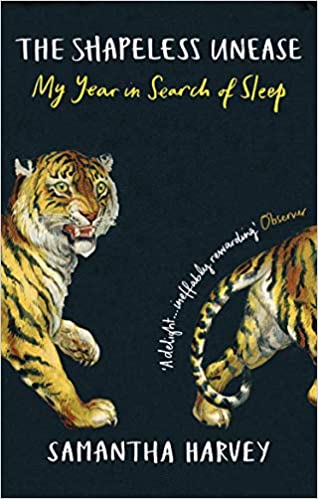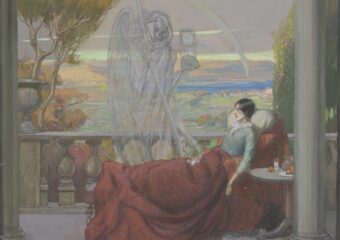Samantha Harvey
New York
Grove Press
2021
176 pages
According to the Art:
The book is a deep and ranging analysis of insomnia causes, consequences, and fixes in the midst of daily life as Harvey experiences it. She emphasizes the effects insomnia has on her being.
Synopsis:
In the opening dialog, the author, Samantha Harvey, tells a friend what this book is about.
Friend: What are you writing?
p. 1
Me: Not sure, some essays. Not really essays. Not essays at all. Some things.
Friend: About what?
Me: Not sure. This and that. About not sleeping, mainly. But death keeps creeping in.
That’s as good a description of the book as could otherwise be offered.
As unstructured as the book’s content is, so is the book’s format. The only breaks in the text are distinguished by infinity signs (“∞”). Time stamps are placed within the text between some of these breaks. The times are sequenced during a night (or a composite of nights) when Harvey is awake between midnight and 7:30 am. Texts following the time stamps describe the acute effects of insomnia on her at those particular moments and could be read as diary or journal entries.
Harvey’s insomnia came suddenly at the age of forty-three and morphed into an unrelenting assault that at times made her wonder if the only sleep available to her is the sleep of the dead.
When I don’t sleep and don’t sleep and don’t sleep, I don’t want my life; neither do I have in me the propulsion (courage? know-how?) to take it. So I have to endure my life when it’s unendurable, and this is an impasse.
p. 33
Can I escape this? The sword hangs. There is nothing to put my mind at rest – every day presents a new threat: the night. Every night is a battle, most often lost, and any victory is one day long, until its challenger comes along: the next night. I understand why people kill themselves, or break down.
p. 82
Throughout the book, across all the text sections, and following all the time stamps, Harvey details what insomnia does to her physically, psychologically, and existentially. She desperately explores the possible causes such as menopause, fear, traffic noise, and Brexit among others, and heartbreakingly tells of all she has done to get sleep such as seeing doctors, smiling more, counting blessings, and changing behaviors. None come to any effect, as she reports to her unhelpful doctor.
I do these things, they don’t help.
p. 139
Over time they will.
Over time they haven’t. I feel unhelpable.
Nobody is unhelpable.
I am.
Nobody is.
Just as Harvey had informed her friend, she takes up other topics in other forms that directly or indirectly relate to her insomnia, and sometimes do not relate at all. Among the various forms are vignettes; thoughts and obsessions; meditations; and a short story. Topics include deaths in the family (including a dog’s); peculiarities of different languages; why so many TV shows have the word “secret” in their titles—“nights spent thinking about this” (p. 67); what fuels insomnia; how worry, anxiety, and fear differ from one another; writing; time; and the relationships between science and religion, and between reason and faith. Harvey has a background in philosophy, it shows.
A year on, Harvey discerns a cure for insomnia. Using a metaphor involving swimming against waves and currents or with waves and currents, the cure is to be derived from the “wisdom in knowing that we are sometimes the cause and influencer of our own currents and tides, which we make in otherwise still waters.” She further elaborates on this idea and how it leads to a moment when “you’ll drop each night into sleep without knowing how you once found it impossible.” (p. 175)
Analysis:
The book is a deep and ranging analysis of insomnia causes, consequences, and fixes in the midst of daily life as Harvey experiences it. She emphasizes the effects insomnia has on her being. “There’s a force at work that doesn’t wish for my wellbeing; it feels personal.” (p. 31) She applies her considerable literary skills to creating lasting impressions of the nocturnal suffering persistent insomnia produces.
She speaks, for example, of the “blankness and blackness; the yawning expanse of a night awake,” (p. 5) and “the texture of the passing hours and the texture of my thoughts as the night abrades them.” (p. 26) She refers to “the shapelessness of a life without sleep, where days merge unbounded.” (p. 104) She hears the “distant smear of sound” from an airplane overhead while she’s awake at four in the morning. (p. 89) Many other such examples abound rendering Harvey’s insomnia instructional and unforgettable.
Harvey also displays her literary skills when showing how her thinking becomes counterintuitive when wondering what deal she could cut in return for sleep.
Insomnia has turned me into a haggler…When none of that works, it turns me into a beggar. I find myself pleading with it in the hope it will grant me what I want, when why would it? How could it? How could insomnia grant sleep? Isn’t insomnia the very last thing in the world to plead to for sleep?
pp. 87-88
In the course of seeking help, Harvey offers a critique of the care she received during interactions with her doctor. “No part of me wants to go to the doctor. I’ve come to dread it, to feel in it an absolute humiliation.” (p. 120) Her humiliation comes from imagining what her doctor must think of her always complaining about not getting any sleep.
People in Syria can sleep with bombs falling, why can’t you sleep on your king-size mattress with your winter-togged duvet and your kelp-scented hair on a fake-down pillow under a bomb-free sky? What pea disrupts your sleep, princess? A passing Audi? What paucity and fragility of spirit has left you relying on drugs to do that which is the natural inheritance of all animals everywhere and forever?
pp. 40-41
Many people with insomnia and other chronic conditions will be familiar with the impression Harvey’s doctor gave her, and may harbor similar resentments. She grants, however, that “some of it can’t be helped – the human body is perishable, medicine is imperfect.” (p. 40) Further to this point, she draws from epistemological problems in science.
At its deepest reaches, experimental science becomes theoretical, abstracting from known observations and data to build explanatory models. Theoretical physicists are as much philosophers as scientists; amid the elasticity of their thinking is the central tenet: I do not know.
p. 98
All this is to say, people “should not let themselves get to the point of needing medicine.” (p. 40) True enough for those who can. To those who can’t, Harvey would advise that they not lose sleep over it.
Also:
Samantha Harvey is the author of many novels, one of which, The Wilderness, was a Man Booker Prize finalist, an Orange Prize finalist, a Guardian First Book Award Nominee, and a Betty Trask Prize winner. The book was also featured in an episode of the podcast, The Clinic & The Person, which covered literary depictions of dementia.
I excerpt additional text describing Harvey’s experience with insomnia and compare it to classic biomedical text on insomnia here.
A version of this post is at the NYU Literature, Arts and Medicine Database.



